#Jane Landers
Explore tagged Tumblr posts
Text


#spiderman#peter x mj#peter x mary jane#marvel universe#marvel#mcu#lander#luke x zander#the music freaks#tmf
5 notes
·
View notes
Text
Pressing On To Maturity
“You are only young once, but you can stay immature indefinitely,” once quipped the humorist and American poet Ogden Nash. I suppose there’s something attractive about the Peter Pan mentality of enjoying the carefree life of childhood, never growing up, and avoiding adulting. Continue reading Untitled

View On WordPress
#Abigail Van Buren#Ann Landers#David A. Bednar#Henri-Louis Bergson#jane Austen#Sowing Seeds for Spiritual Growth#Sydney J. Harris
0 notes
Text
Red Butler/Swap AU Character guide list
This list does not go in order and only has characters that have been swapped with already/confirmed to be swapped with another, more will be added/changed when I figure them out Elizabeth Midford <- -> o!Ciel Phantomhive Alois Trancy <- -> r!Ciel/Sirius Phantomhive Grell Sutcliff <- -> Sebastian Michaelis Ran-Mao <- -> Mey-Rin Joanna <- -> Baldroy Soma Asman Kadar <- -> Finnian Paula <- -> Tanaka Drossel Keinz <- -> Snake
Irene Diaz <- -> Pluto Madame Red <- -> Lau Francis Midford <- -> Rachel Phantomhive Alexis Leon Midford <- -> Vincent Phantomhive Hannah Annafellows<- -> William T. Spears Wolfram Gelzer <- -> Ronald Knox Agni <- -> Othello Claude Faustus<- -> Undertaker Sascha, Ludger <- -> Timber, Canterbury (Third triplet does exists, they're just an extra) Ash Landers <- -> Rian Stoker Angela Blanc <- -> Nina Hopkins Layla <- -> Sieglinde Sullivan Charles Grey <- -> Joker Charles Phipps <- -> Dagger Jane <- -> Beast Joanne Harcourt <- -> Doll Johann Agares <- -> Jumbo Edward V <- -> Peter Richard <- -> Wendy Viscount Druitt <- -> Blavat Edward Midford <- -> Clayton Maurice Cole <- -> Cheslock Gregory Violet <- -> Edgar Redmond Lawrence Bluewer <- -> Herman Greenhill McMillan <- -> Derrick Arden Baldroy JR <- -> Luka Macken Theodore <- -> Mabel Artie <- -> Oliver
Note: when more characters are revealed in the series as it goes on, chances are some swaps might be changed because they fit newer characters more than previous ones.
#This list took forever but hey hope this helps keep track of swapped characters easier. tried to keep it as simple as possible#again not all characters are shown here so this post will most likely be edited the more this au goes on#or be updated with some swaps changing places because I end up realising they actually fit better than their previous ones#again ty imviotrash for suggesting I make a character guide list#black butler#kuroshitsuji#black butler 2#kuroshitsuji 2#black butler swap au#red butler au#not an art post#not tagging a single one of these characters nuh uh#swap au
55 notes
·
View notes
Text
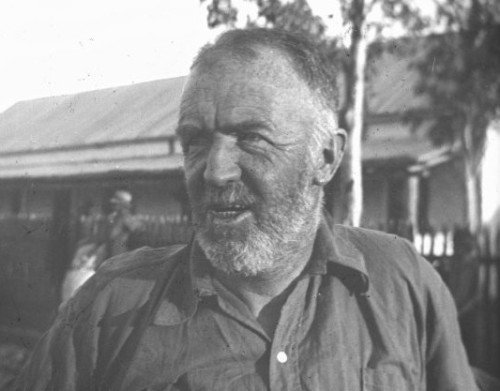
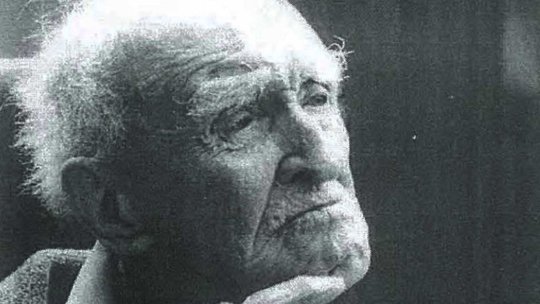
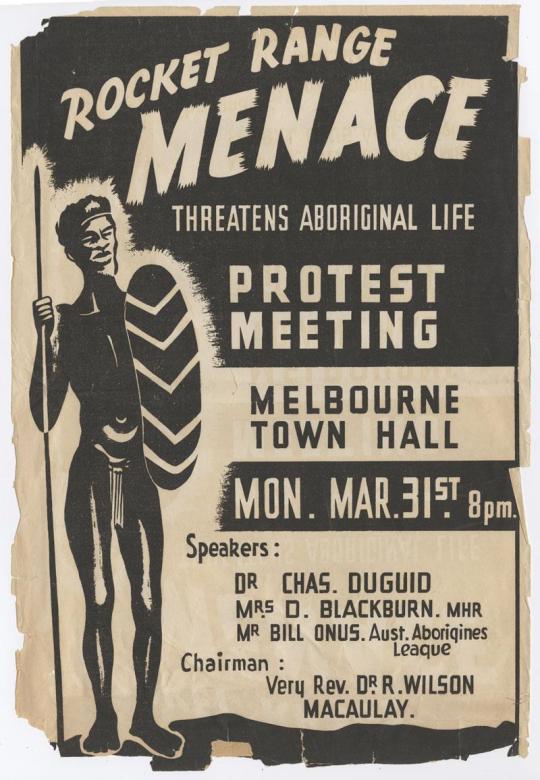
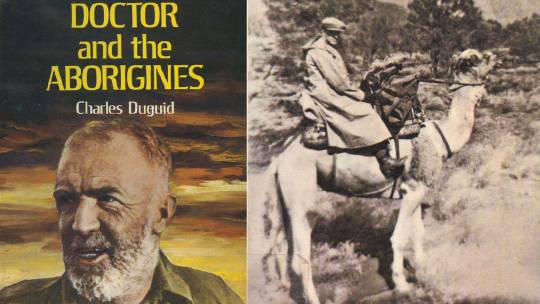
Charles Duguid was born on 6th April 1884 at Saltcoats, Ayrshire.
I only learned of this man 4 years ago, and have to say, if ever there was an apt name for a man “Dr Do Good” as he became known has that honour.
Duguid was the son of Charles Duguid, a teacher, and Jane Snodgrass Kinnier, daughter of Robert S. Kinnier, a surgeon, he attended Ardrossan Academy, where his father was Headmaster between 1882 and 1889, and the High School in Glasgow, before studying medicine at Glasgow University he gained a Master of arts in 1905 before going on to gain degrees in Medicine and surgery. Whilst teaching at Glasgow University, Duguid worked as a doctor in the slums of Glasgow, but in 1911 he signed on as ship’s surgeon for a voyage to and from Australia. This experience led him to emigrate to Australia in 1912. His early medical work in the Glasgow slums developed in him a compassion for the underdog which continued throughout his 102-year life.
After settling in Victoria and marrying an Australian lass, who tragically died in 1927, he remarried in 1930, both Duguid and his wife were idealists and humanitarians, the murder of a white man by Aboriginals at Landers Creek, Northern Territory, sparked Duguid’s interest in their rights.
The police shot 17 Aboriginals during the course of the hunt for the murderer, but official records at the time state that at least 31 people were killed. In 1934 he headed to Darwin, but missed his connection from Alice Springs after responding to a request to perform some emergency surgery there and stayed on for three weeks. He was appalled at the way Aboriginal people were treated there and by their poor living conditions.
Duguid’s wife Phyllis, founded the Aboriginal Advancement League in 1935 and Duguid served as President. In 1937, Duguid helped to found Ernabella Mission in the Musgrave Ranges of South Australia. He lectured and spoke in the UK as well as Australia and New Zealand about the conditions of the Australian Aborigines.
Duguid was active in other organizations concerned with the advancement of Aboriginal rights such as the Council for Aboriginal Rights and the Association for the Protection of Native Races. He also led the 1947 campaign against the establishment of a British-Australian rocket testing program at Woomera in the Central Australian Desert. He worked closely with Donald Thompson to inform the public of the harmful effect that this program would have on those people still living traditionally, nearby.
In addition to his work with Australian Aborigines, Duguid helped to found the Australian branch of the English-Speaking Union, of which he was Chairman in 1932. In 1935, he was elected Moderator of the Presbyterian Church of South Australia. Duguid died in Adelaide on December 5th, 1986 at the age of 102.
Check out this link for the full story of this good man http://adb.anu.edu.au/biography/duguid-charles-12440
13 notes
·
View notes
Text
First look photos of new Stan series Scrublands based on the best-selling novel
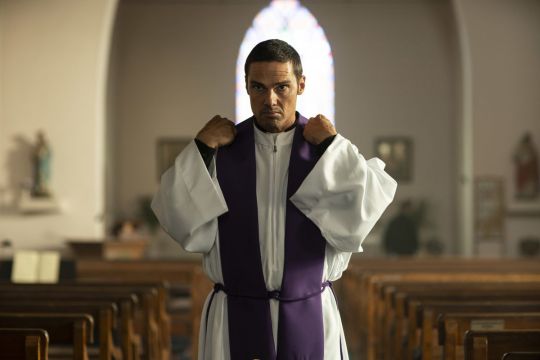
Australia's unrivalled home of original productions has released first look images for the Stan Original Series Scrublands, premiering November 16, only on Stan.
Based on the award-winning novel written by Chris Hammer, Scrublands stars Luke Arnold, Bella Heathcote and Jay Ryan.
If you can't wait for the new series to premiere on November 19, never fear – we've got a glimpse of what to expect before it airs later this month.
The Stan Original Series Scrublands premieres November 16, all episodes at once and only on Stan.
Scroll through to catch a sneak peek of what to expect from Scrublands…

Byron Swift (Jay Ryan)
The series is set in Riversend, an isolated and struggling country town in rural Victoria, where charismatic and dedicated young priest Byron Swift (Jay Ryan) calmly opens fire on his congregation, killing five parishioners.

Martin Scarsden (Luke Arnold) and Jane Gibson (Eliza Matengu)
One year later investigative journalist Martin Scarsden (Luke Arnold) arrives in Riversend to write what should be a simple feature story on the anniversary of the tragedy.
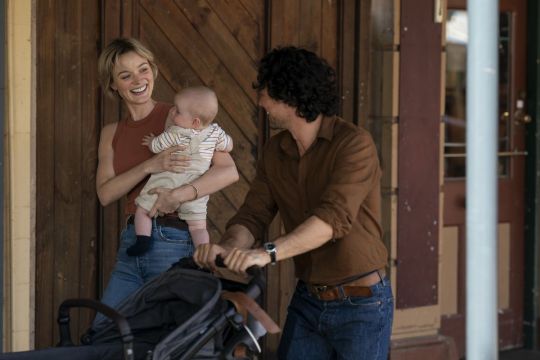
Mandy Bond (Bella Heathcote) and Martin Scarsden (Luke Arnold)
Martin finds a town deeply scarred and hostile to journalists – local bookstore owner Mandy Bond (Bella Heathcote).

Martin Scarsden (Luke Arnold) and Constable Robbie Haus-Jones (Adam Zwar)
Constable Robbie Haus-Jones (Adam Zwar) and widow of one of the massacre victims, Fran Landers (Victoria Thaine, not pictured) give him short shrift.

Martin Scarsden (Luke Arnold)
When Martin's investigative instincts kick in and he digs beneath the surface.

Byron Swift (Jay Ryan)
The previously accepted narrative from the entire town begins to fall apart exposing the events of a year ago aren't all that they seem.
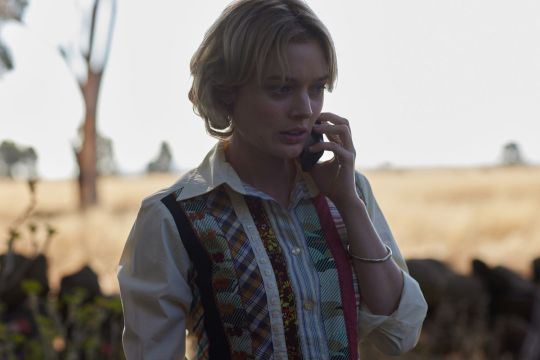
Mandy Bond (Bella Heathcote)
The Riversend townspeople and Martin finds themselves in a life and death race to uncover the truth.
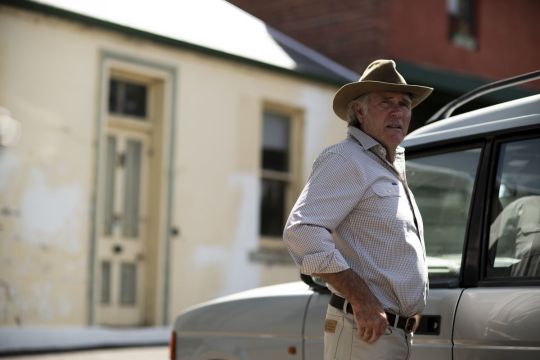
Harley Reagan (Robert Taylor)
The cast also includes Robert Taylor, [pictured] (The Newsreader), Adam Zwar (Squinters), Zane Ciarma (Neighbours), Victoria Thaine (Nowhere Boys), Stacy Clausen (True Spirit), Alison White (Satisfaction), Genevieve Morris (Stan Original Series No Activity) and newcomer Ella Ferris.

Byron Swift (Jay Ryan) and Katherine Bond (Alison Whyte)
Source: Nine
#black sails#luke arnold#john silver#scrublands#bella heathcote#jay ryan#stan on australia#promotional still
35 notes
·
View notes
Text

✨ AUGUST WRAPUP ✨
Total books finished: 30 (wtf?)
DNF’s: 7
Pages read: 8,746
Hours listened: 70.92
[instagram]
Currently reading:
📖 Sucker Punch: Out of the Blue by Kayla Faber (8%)
🎧 Words of Radiance by Brandon Sanderson (30%)
⭐️⭐️⭐️⭐️⭐️
-A Sorceress Comes to Call by T Kingfisher*
-Sucker Punch by Kayla Faber*
-The Sunbearer Trials by Aiden Thomas (reread) 🎧
-The Heart of the World by Amie Kaufman*
-Gentlest of Wild Things by Sarah Underwood*
⭐️⭐️⭐️⭐️.5
-Compound Fracture by Andrew Joseph White*
-The Magpie Lord by KJ Charles
-A Case of Possession by KJ Charles
-The Isles of the Gods by Amie Kaufman (reread) 🎧
-This Fatal Kiss by Alicia Jasinska*
⭐️⭐️⭐️⭐️
-Mortal Follies by Alexis Hall (reread) 🎧
-Yes No Maybe So by Becky Albertalli and Aisha Saeed
-Confounding Oaths by Alexis Hall*
-Winter of the Wolf by Amanda Willimott*
-The Gentleman’s Guide to Getting Lucky by Mackenzi Lee (reread) 🎧
-Celestial Monsters by Aiden Thomas*
-Hot Summer by Elle Everhart
-Flight of Magpies by KJ Charles
-Murder at the Matinee by Jamie West*
-Fake Dates and Mooncakes by Sher Lee (reread) 🎧
-Countess by Suzan Palumbo*
-Saving Graces by Ruby Landers*
-I’m Not Really Here by Gary Lonesborough*
-Nightbirds by Kate J Armstrong (reread) 🎧
-Fyrebirds by Kate J Armstrong*
⭐️⭐️⭐️.5
-One Night in Hartswood by Emma Denny
-Queen B by Juno Dawson*
⭐️⭐️⭐️
-Thyme Travellers edited by Sonia Sulaiman*
-The Gilded Ones by Namina Forna
-Who Could Love You, Astor Price? by Amy Jane Lehan*
DNF
-Just Haven’t Met You Yet by Sophie Cousens (16%)
-You’re the Problem, It’s You by Emma R Alban* (37%)
-Netherford Hall by Natania Barron* (26%)
-Not For the Faint of Heart by Lex Croucher* (54%)
-A Dark and Drowning Tide by Allison Saft* (47%)
-SMP title* (28%)
-At the End of the River Styx by Michelle Kulwicki* (34%)
*indicates gifted item





3 notes
·
View notes
Text
Welcome to my Blog!
Hello there! I'm a predominantly Character!Reader writer who will do scenarios, one-shots, fics, and headcannons!
Be Warned; I Write Night Raven College as an actual college so the students are young adults (Ortho is still baby). For MHA, I'm writing AFTER the War where the characters are all Pro Heroes and 18+ so be careful if you don't want spoilers for that.
Fandoms and Characters I Write For
Obey Me! Shall We Date?
The Brothers
Diavolo
Barbatos
Simeon (+ platonic!Luke)
Solomon
Disney's Twisted Wonderland
Heartslabyul
Savanaclaw [My Dorm]
Octavinelle
Scarabia
Pomefiore
Ignihyde (Ortho is Platonic)
Diasomnia
Yuuya Kuroki {Novel Yuu}
Genshin Impact (Children/Teens Are Strictly Platonic)
Aether
Dainsleif
Mondstadt
Liyue
Inazuma
Sumeru [I Don't Write For Dori]
Fontaine
My Hero Academia
Class 1-A [I Don't Write For Mineta]
Hitoshi Shinsou
Shouta Aizawa
Dabi
Tomura Shigaraki
Geten
Eri (Platonic)
Bungou Stray Dogs
The Armed Detective Agency [I Don't Write For The Tanizaki Twins] (Platonic Fukuzawa & Kyōka)
Chuuya Nakahara
Ryūnosuke Akutagawa
Nikolai Gogol
Fyodor Dostoevsky
Sigma
Saigiku Jōno
Tetchō Suehiro
Black Butler (Ciel, Finny, Soma & Alois Are Platonic)
Phantomhive Manor
Trancy Manor
Snake
Pluto
Agni
Drossel Keinz
Undertaker
Ash Landers
Honkai Star Rail
Dan Heng
Blade
Caelus
Gepard
Veritas Ratio
Boothill
Aventurine
Sunday
Argenti
Luka
Luocha
Jing Yuan
The Remarried Empress
Navier
Sovieshu (Reactions Only)
Platonic Rashta
Heinley/Heinrey
Kosair
Duke Kaufman
McKenna
Duke Ergi
Beauty and The Beasts (Reader Is Depicted As Beastperson Capable Of Shifting Regardless Of Gender)
Winston
Shuu
Muir
Curtis
Parker
Harvey
Bluepool
Qin
Molly/Jane
Romance In The Beastworld (Same As Beauty and The Beasts)
White King/Bai Di
Frost Cloud/Shuang Yun
Sang Ye
Lin Huanhuan
Inuyasha
Inuyasha
Kagome
Sesshōmaru
Koga
Avatar: The Last Airbender
Zuko
Mai
Platonic Gaang
Platonic Azula
Stardew Valley
The Bachelors (Platonic Shane)
The Bachelorettes
Durarara!!
Shizuo Heiwajima
Kasuka Heiwajima
Izaya Orihara
Celty Sturluson
Shinra Kishitani
Vorona (Platonic)
Kyōhei Kadota
Walker Yumasaki
Erika Karisawa
Saburo Togusa
Chikage Rokujō
Servamp
Kuro | Sleepy Ash
Mahiru Shirota (Platonic)
Hyde | Lawless
Licht Jekylland Todoroki
Jeje | Doubt-Doubt
Mikuni Alicein
Freya | The Mother
Ildio | World End
Misono Alicein (Platonic)
Snow Lily | All of Love
Tsubaki
Berkia
Sakuya Watanuki (Platonic)
Characters I Write Reader As
Pretty much everyone I write for I'll write the reader as; however, be specific with how you want your request. If you ask for X Character!Reader, it's usually romantic. If you ask for & Character!Reader, it's usually platonic.
I will not write Character!Reader if the character reader is to be based off is a child, i.e. Klee!Reader. If you want Character!Reader to be that specific character, I write them as being an older sibling of that character and having similar characteristics. [This is the only exception I will make as I am a primarily Character!Reader blog]
I will, however, write Character!Reader based off a teenage character, i.e. Crona!Reader; this is strictly platonic.
I write gender-neutral pronouns unless requested otherwise.
I'll also write Character!Reader when the character is from a fandom not listed here, like Chat Noir!Reader (in the context of Reader having the Cat Miraculous). If you're not sure, you can ask; I'm not terribly mean. [If you're interested in Human Sans/Papyrus!Reader, I'm up for writing them as well]
What I Write
Family Bonding
Angst
Fluff
Comfort
SFW
Slightly Suggestive
Same-Sex Relationships
Found Family
Family Feels
Pregnancy
What I DON'T Write
Pedophilia
Yandere
Homophobia
Transphobia
Most Fetishes
Paraphilia
Abuse
Self-Harm
Suicide
NSFW [Originally in DO write but the more I thought about it, the more awkward I felt thinking about it so I'm taking it off the table]
#obey me x reader#twisted wonderland x reader#genshin impact x reader#my hero academia x reader#boku no hero academia x reader#mha x reader#bnha x reader#bsd x reader#bungou stray dogs x reader#hsr x reader#honkai star rail x reader#the remarried empress x reader#remarried empress x reader#beauty and the beasts x reader#romance in the beastworld x reader#black butler x reader#kuroshitsuji x reader#inuyasha x reader#avatar the last airbender x reader#atla x reader#stardew valley x reader#sdv x reader#durarara x reader#servamp x reader
8 notes
·
View notes
Text
BRACKET REVEAL
At last, the highly anticipated bracket reveal for the Akuma 6 V2 is now out! Before viewing this bracket, please keep in mind that I randomized who goes against who so that I wouldn't be biased in my decision. Regarding the decision of who made it in the bracket, I took the results from my Google Form I put out a few weeks ago, while also considering some of the most popular fan favorite characters and consulting outside help. So if you're wondering why a certain character isn't there, or why an "unpopular" character is there, that is the reason why. Also, since the size of the bracket is so huge, the image quality is SUPER LOW, which is why I included a PDF of the bracket so you can zoom in a higher quality. Without further ado, here is the official bracket:

And here is the link to the PDF where you can freely zoom in
I know its super small, which is why I am including a text description of who is going against who in round one:
Rachel Phantomhive vs William T. Spears
Elizabeth Ethel Cordelia Midford vs Alois Trancy
Undertaker vs Lawrence Anderson (Pops)
Blavat Sky vs Drocell Keinz
Jane vs Grelle Sutcliff
Mey Rin vs Frederick Abberline
Ronald Knox vs Edgar Redmond
Alan Humphries vs Ash/Angela Landers
Lau vs Herman Greenhill
Tanaka vs Othello
Charles Grey vs Soma Asman Kadar
Doll vs Sebastian Michaelis
Snake’s snakes vs Nina Hopkins
Sieglinde Sullivan vs Bard
Sascha vs Agni
Angelina Dalles vs Vincent Phantomhive
Wolfram Gelzer vs Lawrence Bluewer
Gregory Violet vs Hannah Annafellows
Ciel Phantomhive vs Ran Mao
Snake vs Ludger
Butler Grelle vs Finnian
Eric Slingby vs Thomas Wallis
Charles Phipps vs Joker
Sharpe Hanks vs “Ciel” Phantomhive
Asks and submissions are open for questions and propaganda posts! Please remember to have fun, be kind to each other, and remember this is just for fun.
Round one will be posted tomorrow, Monday March 6th at 12 P.M. EST!
51 notes
·
View notes
Text

After the cut is the final list of characters that will be in the poll, aside from any new characters that are introduced in chapter 199.
Abbie
Ada
Agni / Arshad Satyendra Iyer
Akashi
Al
Alan Humphries
Aleister Chamber / Viscount of Druitt
Alexis Leon Midford
Alois Trancy / Jim Macken
Angela Blanc
Angelina Dalles / Madam Red / Aunt An
Anne Drewanz
Annie
the archeologist (Season 2 character)
Arihito Genpou
Aristocrat of Evil with the scarred face
Arnold Trancy
Artie
Arthur Conan Doyle
Arthur Randall
Ash Landers
Aurora Society member (first one O!Ciel and Seb meet)
Aurora Society purified water seller
Azzurro Vanel
Baldroy / Bard / Baldo
Baldroy Jr.
Baldroy's cow
the bear
Beast
beggar boy that Soma gives a necklace to, mother, and baby brother
Betty
Bitter Rabbit
bizarre dolls
bizarre doll horses
Blavat Sky
Bloodbath Johnny
Bronte
Burnett
Canterbury
Carter
the cat from the live action movie
the cats Sebastian rescues from the rain
Cedric Brandel
Cedric K. Ros
CGI horses / driver
Charles Bennett Sato
Charles Grey
Charles Phipps
Charles Phipps's chicken
Chef Lach
Chef Rickman
Chef Tarpin
Chef Wollest
Cheslock
Chlaus
Chris Heathfield
Chris Heathfield's Chris Heathfield's maids
Ciel Phantomhive bizarre doll / Real Ciel / R!Ciel
Ciel Phantomhive child / R!Ciel child
"Ciel" Phantomhive / Our Ciel / O!Ciel
Ciel's horse
Claude Faustus
Claude's birds
Cloudia Phantomhive
Clayton
Conny
Countess Trancy and her baby
the cultists
Dagger
Damian
Daniel
"Deer"
demon Ciel
demon Crow
demon "pet" (the xenomorph)
Derrick Arden
Diedrich
Doctor
Doll / Freckles
Donne
Dove
Drossel Keinz
Drossel's dolls
Edgar Redmond
Edward Abberline
Edward Midford
Edward V
Elizabeth Midford / Lizzy
Ellery Nixon
Emily
Eric Slingby
Fennian
Finnian / Finny
Finny's hat
FOL Orphanage staff
Francis Midford
Fred Abberline
Funtom Corporation's unicorn suit
Georg von Siemens
German countryman
Ginny
Goethe
Green House dorm master
Gregory Violet
Grelle Sutcliff
Grelle's chainsaw
Grete Hilbard
Grimsby Keane
Haku
Haku's henchman
Hanae Wakatsuki
Hannah Annafellows
Hao
Harold West Jeb
Heinrich
Henry Barrymore
"Her"
Herman Greenhill
Higham
Hilde Dickhaut
the iceberg
Irene Diaz
Jackknife Haywood
James
Jan
Jane
Japanese man with a katana
Japanese woman with a lunchbox
Jay the Undertaker
Jeremy Rathbone
Joanna
Joanne Harcourt
Johann Agares
John Brown
John Brown's horse
Johnny
Joker
Julius Pitt
Jumbo
Karl Woodley
Keats
Kelvin
kenpo master
King's Bear prostitutes
Lau
Lau's girls
Lawrence Anderson / Pops
Lawrence Bluewer
Lawrence Bluewer's sisters
Layla
Lord Ackroyd
Lord Ackroyd's son
Lorraine McDowell
Ludger
Luka Macken
the Mad Dog of Venice
Mabel
Margaret Connor
Margaret Connor's father
Margaret Turner
Maria
Mathilda Simmons
Maurice Cole
McDowell
McMillan
Mey-Rin
Milly
Mina
Miranda
Mrs. Mayell
Munemitsu Aoki
Nicholas
Nick
Nina Hopkins
Nina's assistants
O!Ciel's land renters
Oliver
the orphan that called Sebastian an old guy
Oscar
Othello
the other children in the lab Finny was kept in
Paul Jones
the Panzer
Patrick Phelps
Patrick the Grey Wizard
Paula
Peter
Phantomhive family ring
Pitt
Pluto
Polaris
priest (from Season 2)
Prince Albert
Prince Albert puppet
Professor Sullivan / village crone
Purple House dorm master
Purple House prefect from Vincent's year
Queen Victoria
Queen Victoria (Season 1)
Rachel Phantomhive
Ran-Mao
Reaper managers
Reaper trainees
Red House dorm master
Red House prefect from Vincent's year
Richard
Ridley
Rian Stoker
Rin
Ronald Knox
Ronald's lawnmower
the Rowdy Count
Sam / Old Man Sam
Sam's grandson
Saneatsu Nekoma
Sascha
Scotland Yard officers
Sebastian Michaelis
the Sebastian Roomba
Sebastian the dog
Sebastian's silverware
Sharpe Hanks
Shiori Genpou
Sieglinde Sullivan
Sieglinde Sullivan's father
Snake
Snake's unnamed snakes
Soma Asman Kadar
Soma's elephant
Sophie Smith
Sphere Music Hall staff
Stella Rose
Susan
Susannah Connor
Tanaka
Terry
Theodore
Thomas Wallis
Thompson
Timber
the timetable guy
the train kidnapper
Trancy / Former Head Trancy
the turnspit dog
Undertaker
Undertaker's death scythe
Undertaker's mourning lockets
Vicar Rathbone
Vincent Phantomhive
Vincent Phantomhive's staff
walking stick shopkeeper
Webster
Wendy
the "werewolves"
Wilde
William T. Spears
William's death scythe
William's pigeons
Wolfram Gelzer
Wordsworth
Yana Toboso
17 notes
·
View notes
Text
If you like ___ then read ___ - Studio Ghibli Edition
No, I am not giving any context :)
Howl’s Moving Castle
Sorcery of Thorns by Margret Rogerson
Clockwork Angel by Cassandra Clare
Howl’s Moving Castle by Diana Wynn Jones
Castle in the Sky
Starflight by Melissa Landers
To Kill a Kingdom by Alexandra Christo
Truthwitch by Susan Dennard
Grave of the Fireflies
The Book Thief by Markus Zusak
The Kite Runner by Khaled Hosseini.
To Kill a Mockingbird by Harper Lee
The Cat Returns
The Cat Who Saved Books by Louise Heal Kawai
The Lion, the Witch, and the Wardrobe by C.S. Lewis
The Golden Compass by Philip Pullman
Kiki’s Delivery Service
We Ride Upon Sticks by Quan Barry
The Ex Hex by Rachel Hawkins
Mooncakes by Suzanne Walker
My Neighbour Totoro
Tuck Everlasting by Natalie Babbitt
The Wind in the Willow by Kenneth Grahame
Fairy Tale: A True Story by Monica Kulling
Spirited Away
A Darker Shade of Magic by V.E. Schwab
The Screaming Staircase by Jonathan Stroud
Gregor the Overlander by Suzanne Collins
Princess Mononoke
The City of Brass by S.A. Chakraborty
An Ember in the Ashes by Sabaa Tahir
Flame in the Mist by Renee Ahdieh
Only Yesterday
The Midnight Library by Matt Haig
Under the Whispering Door by T.J. Klune
The Secret Garden by Frances Hodgson Burnett
The Secret World of Arrietty
The Borrowers by Mary Norton
Wild Beauty by Anna Marie McLemore
Bridge to Terabithia by Katherine Paterson
When Marnie Was There
My Sister’s Keeper by Jodi Picoult
Little Women by Louisa May Alcott
When the Butterflies Came by Kimberley Griffiths Little
Ponyo
Between the Lines by Samantha Van Leer & Jodi Picoult
Fathomless by Jackson Pearce
Midnight Pearls by Debbie Viguie
The Wind Rises
All the Light We Cannot See by Anthony Doerr
The Fault in Our Stars by John Green
Everything, Everything by Nicola Yoon
From Up on Poppy Hill
The Once and Future Witches by Alix E. Harrow
Better Together by Christine Riccio
Wonder by R.J. Palacio
Porco Rosso
We Hunt the Flames by Hafsah Faizal
The Gilded Wolves by Roshani Chokshi
Biggles the Camels are Coming by W.E. Johns
Whisper of the Heart
One Last Stop by Casey McQuiston
Fangirl by Rainbow Rowell
The Upside to Unrequited by Becky Albertalli
Nausicaa of the Valley of the Wind
The Last Namsara by Kristen Ciccarelli
Rebel of the Sands by Alwyn Hamilton
The City of Ember by Jeanne DuPrau
Pom Poko
Hollow Kingdom by Kira Jane Buxton
Furiously Happy: A Funny Book About Horrible Things by Jenny Lawson
Hitchhiker's Guide to the Galaxy by Adam Douglas
5 notes
·
View notes
Text
The Kingdom of Kongo and Palo Mayombe: Reflections on an African-American Religion
Abstract
Historical scholarship on Afro-Cuban religions has long recognized that one of its salient characteristics is the union of African (Yoruba) gods with Catholic Saints. But in so doing, it has usually considered the Cuban Catholic church as the source of the saints and the syncretism to be the result of the worshippers hiding worship of the gods behind the saints. This article argues that the source of the saints was more likely to be from Catholics from the Kingdom of Kongo which had been Catholic for 300 years and had made its own form of Christianity in the interim.
Acknowledgements
Research funding for this project was supplied by Boston University Faculty Research Fund and the Hutchins Center of Harvard University. Earlier versions were presented at the Hutchins Center, and the keynote address at ‘Kongo Across the Waters’ in Gainesville, FL. Thanks to Linda Heywood, Matthew Childs, Manuel Barcia, Jane Landers, Carmen Barcia, Jorge Felipe Gonzalez, Thiago Sapede, Marial Iglesias Utset, Aisha Fisher, Dell Hamilton, Grete Viddal and Kyrah Daniels for readings, comments, questions and source material.
[1] Robert Farris Thompson, Flash of the Spirit: African and Afro-American Art and Philosophy (New York: Random House, 1983), pp. 17–8; see also Face of the Gods: Art and Altars of Africa and African America (New York: Prestel, 1993). For Cuba in particular, see David H. Brown, Santería Enthroned: Art, Ritual and Innovation in an Afro-Cuban Religion (Chicago, IL: University of Chicago Press, 2003), p. 34 (with ample references to earlier visions).
[2] Georges Balandier, Daily Life in the Kingdom of the Kongo (New York: Allen and Unwin, 1968 [French Version, Paris, 1965]) and James Sweet, Recreating Africa: Culture, Kinship and Religion in the African-Portuguese World, 1441–1770 (Chapel Hill: University of North Carolina Press, 2003).
[3] Ann Hilton, The Kingdom of Kongo (Oxford: Oxford University Press, 1984), for the role of the Capuchins in discovering problems with Kongo's Christianity. John Thornton, ‘The Kingdom of Kongo and the Counter-Reformation’, Social Sciences and Missions 26 (2013): 40–58 contextualizes their role and their problems with Kongo's Christianity.
[4] Adrian Hastings, The Church in Africa, 1450–1950 (Oxford: Oxford University Press, 1994); this position is often implicit in the many histories written by clerical historians such as Jean Cuvelier, Louis Jadin, François Bontinck, Teobaldo Filesi, Carlo Toso and Graziano Saccardo, whose work has presented modern editions of the classical work of the Capuchin missionaries, commentaries and at times regional histories, such as Saccardo, Congo e Angola con la storia del missionari Capuccini, Vol. 3 (Venice: Curia Provinciale dei Cappuccini, 1982–1983). For both a position of dependence on missionaries and a recognition of local education, Louis Jadin, ‘Les survivances chrétiennes au Congo au XIXe siècle’, Études d'histoire africaine 1 (1970): 137–85.
[5] It is not mentioned at all in his seminal work, Thompson, Flash of the Spirit in the nearly 100-page section dealing with Kongo and its influence in Vodou, nor in Face of the Gods.
[6] Erwan Dianteill, ‘Kongo à Cuba: Transformations d'une religion africaine', Archives de Sciences Sociales de Religion 117 (2002): 59–80.
[7] Todd Ochoa, Society of the Dead: Quita Manaquita and Palo Praise in Cuba (Berkeley: University of California Press, 2010), pp. 8–10. Wyatt MacGaffey's work, especially Religion and Society in Central Africa: The BaKongo of Lower Zaire (Chicago, IL: University of Chicago Press, 1986) is a favorite.
[8] Thiago Sapede, Muana Congo, Muana Nzambi a Mpungu: Poder e Catolicismo no reino do Congo pós-restauração (1769–1795) (São Paulo: Alameda, 2014) is the first book length study of Christianity in the later period of Kongo's history.
[9] John Thornton, ‘Afro-Christian Syncretism in the Kingdom of Kongo', Journal of African History 54 (2013): 53–77.
[10] Thornton, ‘Afro-Christian Syncretism'.
[11] Sapede, Muana Congo, pp. 248–57.
[12] Thornton, ‘Afro-Christian Syncretism', for the details of the struggle, but a perspective that sees the Capuchin mission as central to Kongo Christianity, see Saccardo, Congo e Angola.
[13] John Thornton, The Kongolese Saint Anthony: D Beatriz Kimpa Vita and the Antonian Movement, 1684–1706 (Cambridge: Cambridge University Press, 1998).
[14] Rafael Castello de Vide, ‘Viagem ao Congo’, Academia das Cienças de Lisboa, MS Vermelho 396, pp. 32–4, 183–5 (transcription by Arlindo Carreira, 2007 at http://www.arlindo-correia.com/161007.html) which marks the pagination of the original MS.
[15] Castello de Vide, ‘Viagem ao Congo', pp. 110–4.
[16] Raimondo da Dicomano, ‘Informazione' (1798), pp. 1–2. The text exists in both the Italian original and a Portuguese translation made at the same time. For an edition of both, see the transcription of Arlindo Carreira, 2010 (http://www.arlindo-correia.com/121208.html).
[17] ‘Il Stato in cui si trova il Regno di Congo', September 22, 1820, in Teobaldo Filesi, ‘L'epilogo della ‘Missio Antiqua’ dei cappuccini nel regno de Congo (1800–1835)’, Euntes Docete 23 (1970), pp. 433–4.
[18] Among the first was Domingos Pereira da Silva Sardinha in 1854, who, according to King Henrique II of Kongo, had performed his duties of administering the sacraments with ‘all the necessary prudence', Henrique II to Vicar General of Angola, December 14, 1855, Boletim Oficial de Angola, 540 (1856).
[19] Biblioteca d'Ajuda, Lisbon, Códice 54/XIII/32 n° 9, Francisco de Salles Gusmão to the King, October 27, 1856.
[20] Castello de Vide, ‘Viagem ao Congo’, pp. 110–4.
[21] da Dicomano, ‘Informazione', pp. 1–7 (of manuscript).
[22] Castello de Vide, ‘Viagem', pp. 39, 69, 276.
[23] Castello de Vide, ‘Viagen', p. 217 (thanks to Thiago Sapede for this reference).
[24] Castello de Vide, ‘Viagem’, pp. 32–4, 1835.
[25] For a thorough study of these religious artefacts and their meaning, see Cécile Fromont, The Art of Conversion: Christian Visual Culture in the Kingdom of Kongo (Chapel Hill: University of North Carolina Press, 2014).
[26] Castello de Vide, ‘Viagem', p. 78.
[27] APF Congo 5, fols. 298–298v (Rosario dal Parco) ‘Informazione 1760' A French translation is found in Louis Jadin, ‘Aperçu de la situation du Congo, et rite d’élection des rois en 1775, d'après le P. Cherubino da Savona, missionaire de 1759 à 1774', Bulletin de l'Institut Historique Belge de Rome 35 (1963): 347–419 (marking foliation of original MS).
[28] Castello de Vide, ‘Viagem', pp. 180–4.
[29] Castello de Vide, ‘Viagem', p. 53.
[30] Castello de Vide, ‘Viagem', pp. 63–4; see also 87 for another noble as Captain of Church; 136 crowds at Mapinda.
[31] da Dicomano, ‘Informazione', pp. 1–7.
[32] Castello de Vide, ‘Viagem', p. 196.
[33] Bernard Clist et alia, ‘The Elusive Archeology of Kongo Urbanism, the Case of Kindoki, Mbanza Nsundi (Lower Congo, DRC)’, African Archaeological Review 32 (2014) 369–412 and Charlotte Verhaeghe, ‘Funeraire rituelen en het Kongo Konigrijk: De betekenis van de schelp- en glaskralen en de begraafplaats van Kindoki, Mbanza Nsundi, Neder-Kongo' (MA thesis, University of Ghent, 2014), pp. 44–50.
[34] ‘Il Stato in cui si trova il Regno di Congo', September 22, 1820, in Filesi, ‘Epilogo’, pp. 433–4.
[35] ‘O Congo em 1845: Roteiro da viagem ao Reino de Congo por Major A. J. Castro … ’, Boletim de Sociedade de Geographia de Lisboa II series, 2 (1880), pp. 53–67. The orthographic irregularity reflects the actual pronunciation of these terms in the São Salvador region (the Sansala dialect).
[36] Alfredo de Sarmento, Os sertões d'Africa (Apontamentos do viagem) (Lisbon: Artur da Silva, 1880), p. 49 and Adolf Bastian, Ein Besuch in San Salvador: Der Hauptstadt des Königreichs Congo (Bremen: Heinrich Strack, 1859), pp. 61–2.
[37] Castello de Vide, ‘Viagem', pp. 102–3 and da Firenze, ‘Relazione', pp. 420–1.
[38] Castello de Vide, ‘Viagem', p. 137.
[39] Castello de Vide, ‘Viagem', pp. 180–4.
[40] da Dicomano, ‘Informazione', pp. 1–7.
[41] Castello de Vide, ‘Viagem', pp. 32–4; da Dicomano, ‘Informazione', pp. 1–7; Zanobio Maria da Firenze, ‘Relazione della Stato in cui si trovassi autalmente il Regno di Congo … 1814’, July 10, 1816, in Filesi, ‘Epilogo’, pp. 420–1.
[42] Archivio ‘De Propaganda Fide' (Rome) Acta 1758, ff 213–9, no. 16, Relazione di Rosario dal Parco, July 31, 1758. These large numbers were not simply priests catching up on people who had not been baptized for a long time, as personnel staffing and statistics are found from 1752 onward; but the priests did not cover the whole country every year, so many priests would baptize babies all under age two or three.
[43] Castello de Vide, ‘Viagem', pp. 63–4; see also 87 for another noble as Captain of Church; 136 crowds at Mapinda.
[44] da Dicomano, ‘Informazione', pp. 1–7.
[45] da Firenze, ‘Relazione', pp. 420–1.
[46] ‘Il Stato in cui si trova il Regno di Congo', September 22, 1820, in Filesi, ‘Epilogo’, pp. 433–4.
[47] Francisco das Necessidades, Report, March 15, 1845, in Arquivo do Archibispado de Angola, Correspondência de Congo, 1845–1892, cited in François Bontinck, ‘Notes complimentaire sur Dom Nicolau Agua Rosada e Sardonia’, African Historical Studies 2 (1969): 105, n. 6. Unfortunately, no researchers have been allowed to work in this section of the archive for many years and so the actual text is not available.
[48] Report of November 13, 1856 in António Brásio, ‘Monumenta Missionalia Africana’, Portugal em Africa 50 (1952), pp. 114–7.
[49] Biblioteca d'Ajuda, Lisbon 54/XIII/32 n° 9, Francisco de Salles Gusmão to the King, de Outubro de 27, 1856.
[50] Da Cruz, entry of October 8 and 25 on the problems of baptizing people.
[51] da Dicomano, ‘Informazione', is the first to describe this process; for more detail see Bastian, Besuch.
[52] David Eltis, An Atlas of the Transatlantic Slave Trade.
[53] For a recent discussion of names and nomenclature, see Jésus Guanche, Africanía y etnicidad en Cuba (los componentes étnicos africanos y sus múltiples demoninaciones (Havana: Editoria de Ciencias Sociales, 2008). As we shall see, a number of other subdivisions also derived from the kingdom like the Musolongos, Batas and others.
[54] John Thornton, Africa and Africans in the Formation of the Atlantic World, 1400–1800, 2nd ed. (Cambridge: Cambridge University Press, 1998), for Cuba in particular, Matt Childs, ‘Recreating African Identities in Cuba', in The Black Urban Atlantic in the Era of the Slave Trade, eds. Jorge Cañizares-Esquerra, Matt Childs, and James Sidbury (Philadelphia: University of Pennsylvania Press, 2013), pp. 85–100.
[55] Robert Jameson, Letters from Havana in the Year 1820 … (London: John Miller, 1821), pp. 20–2 (from letter II).
[56] Fernando Ortiz, Hampa Afro-Cubana. Los Negros Brujos (Havana: Liberia de F. Fé, 1906), pp. 81–5; and further developed in ‘Los Cabildos Afrocubanos', in Ensayos Etnograficos, eds. Miguel Barnet and Angel Fernández (Havana: Editoriales Sociales, 1984 [originally published 1921]), pp. 12–34; for a more recent statement based on more research, Matt Childs, The 1812 Aponte Rebellion and the Struggle Against Atlantic Slavery (Chapel Hill: University of North Carolina Press, 2006), pp. 209–45 and María del Carmen Barcia Zequeira, Andrés Rodríguez Reyes, and Milagros Niebla Delgado, Del cabildo de “nación” a la casa de santo (Havana: Fundación Fernando Ortiz, 2012).
[57] For example, the now famous community of Pindar del Rio, see Natalia Bolívar Arostegui, Ta Makuende Yaya y las Reglas de Palo Monte: Mayombe, brillumba, kimbisa, shamalongo (Havana: Ediciones UNION, 1998).
[58] Childs, Aponte Rebellion, pp. 209–12; Jane Landers, ‘Catholic Conspirators: Religious Rebels in Nineteenth Century Cuba', Slavery and Abolition 36 (2015): 495–520.
[59] Brown, Santería Enthroned, pp. 62–112; María del Carmen Barcia, Los ilustres apellidos: Negros en la Habana colonial (Havana: Oficina del Historiador de la Ciudad, 2008), pp. 45–151; Barcia, Rodríguez Reyes, and Niebla Delgado, Del Cabildo which carefully demolishes the earlier theses of Fernando Ortiz and others that the cabildos grew out of the brotherhoods.
[60] This group must have split or been replaced by another, for a property dispute in the Congos Loangos relates to their foundation in 1776, Archivo Nacional de Cuba (ANC) Escribanía Valerio-Ramirez (VR) legajo 698, no. 10.205.
[61] Barcia, Iustres Apellidos, pp. 45–151.
[62] Barcia, Ilustres Apellidos.
[63] del Carmen Barcia Zequeira, Rodríguez Reyes, and Niebla Delgado, Del cabildo, pp. 12–9.
[64] Fernando Ortiz, ‘Los Cabildos Afrocubanos', in Ensayos Etnograficos, eds. Miguel Barnet and Angel Fernández (Havana: Ediciones Ciencas Sociales, 1984 [originally published 1921]), p. 13, citing documents in El Curioso Americano, 1899, p. 73.
[65] Proclama que en un cabildo de negros congos de la ciudad de La Habana, prononció por su Presidente Rey Siliman Mofundi Siliman … (Havana: np, 1808); for the claim of superiority, drawn from an ambiguous statement that he was ‘more black that you others’, see Brown, Santería Enthroned, pp. 25–7 and 311, footnotes 4 and 6. For political context, see Ada Ferrer, Freedom's Mirror: Cuba and Haiti in the Age of Revolution (Cambridge: Cambridge University Press, 2014), pp. 247–9.
[66] Fredrika Bremer, Hemmen i den Nya Världen, 2nd ed., Vol. 3 (Stockholm: Tidens forläg, 1854), p. 142 (English translation as The Homes of the New World: Impressions of America, Vol. 2 (New York: Harper and Brothers, 1853), p. 322) Her host's name is given in the original and obscured in the translation as ‘C—'.
[67] Bremer, Hemmen, Vol. 3, pp. 146–8 (Homes Vol. 2, pp. 325–8).
[68] Henri Dumont, Antropologia y patologia comparadas de los Negros escalvos, 1876, trans. Israel Castellanos (Havana: Molina, 1922), p. 38.
[69] Bremer, Hemmen, Vol. 3, pp. 172–4 (Homes Vol. 2, pp. 348–9).
[70] Bremer, Hemmen, Vol. 3, p. 213 (Homes Vol. 2, p. 383).
[71] Esteban Pichardo, Diccionario provincial de voces Cubanas (Matanzas: Imprenta de la Real Marina, 1836), p. 72. Musundi may refer to Kongo's northern province of Nsundi, though the match is not exact since the nasal ‘n' is not incorporated into it, musundi might also mean ‘excellent', as the Virgin Mary was called ‘Musundi Madia' in the Kongo catechism meaning exactly this.
[72] It is possible that Bremer attended the dance of another Cabildo of Congos Reales, who were in the process of declaring their insolvency in 1851, ANC Escrabanía Joaquin Trujillo (JT) leg 84, no. 12, 1851; for a 1867 dispute, see the property case involving them in ANC VR leg. 393, no. 5875; other mentions of cabildos of this name including the group from 1865–1871 in Carmen Barcia, Ilustres apellidos, p. 408. For the 1880s mentions, see Archivio Historico de la Provincia de Matanzas (henceforward AHPM), Religiones Africanas, leg 1, no. 30, July 7, 1882; no. 65, January 9, 1898 and no. 31, July 31, 1886.
[73] Fondo Fernando Ortiz, Institute de Linguistica y Literatura, Havana, 5.
[74] ANC Escibanía d'Daumas (ED) leg 917, no. 6. (foliation uncertain, very deteriorated document).
[75] António de Oliveira de Cadornega, História das guerras angolanas (1680–81 ), eds. Matias de Delgado and da Cunha, Vol. 3 (Lisbon: Agência Geral do Ultramar, 1940–1942, reprinted 1972), p. 3, 193. In July 2011, I drove through all three dialect zones, confirmed some of the differences by hearing them spoken and by speaking with people about these differences. My thanks to Father Gabriele Bortolami, OFMCap for driving, interacting with people, impromptu language updates and occasional lessons in the etiquette of dialect use in northern Angola.
[76] Cherubino da Savona, ‘Breve ragguaglio del Congo … ’, fols. 41v–44v, published with original foliation marked in Carlo Toso, ed., ‘Relazioni inedite di P. Cherubino Cassinis da Savona sul ‘Regno del Congo e sue Missioni’, L'Italia Francescana 45 (1974): 135–214. The foliation of the original is also marked in the French translation, found in Jadin, ‘Aperçu de la situation au Congo … '
[77] ANC ED, leg 494, no. 1, fols 96–97. This text was included in papers dealing with another dispute in 1827–1828 and in 1832–1836.
[78] ANC ED, leg 548, no. 11, fol. 9–9v; José Pacheco, January 21, 1806; ANC ED, leg. 660, no. 8, fols. 1–4; Pedro José Santa Cruz (a request for its own capataz) 1806; for the later dispute ANC ED leg 494, no. 1.
[79] ANC ED, leg 660, no. 8, fol. 4.
[80] ANC JT, leg. 84, no. 13 passim, 1851.
[81] AHPM, Religiones Africanas, leg 1, no. 30, July 7, 1882.
[82] AHPM, Religiones Africanas, leg 1, no. 65, January 9, 1898.
[83] AHPM, Religiones Africanas, leg 1, no. 31, July 31, 1886.
[84] Brown, Santería Enthroned, pp. 55–61 and Barcia Zequeira, Rodríguez Reyes, and Delgado, Cabildo de nación.
[85] Childs, Aponte Rebellion, p. 112 and ‘Identity', p. 91.
[86] Consider the temporal range of inquisition cases cited in Tania Chappi, Demonios en La Habana: Episodios de la Inquisición en Cuba (Havana: Oficinia del Hisoriador de la Ciudad, 2001). For an example of the sort of persecution the Inquisition could do, and the sort of information that can be obtained from their records, see James Sweet's study of slave religious life in Brazil, Recreating Africa.
[87] Jameson, Letters, pp. 20–2.
[88] See the transcript of his interview published in Henry Lovejoy, ‘Old Oyo Influences on the Transformation of Lucumí Identity in Colonial Cuba' (PhD diss., UCLA, 2012), pp. 230–46.
[89] Aisha Finch, Rethinking Slave Rebellion in Cuba: La Escalera and the Insurgencies of 1841–44 (Chapel Hill: North Carolina Press, 2015), pp. 199–220. Finch attributes most of the activities in these cases to the non-Christian part of Kongo religion, or an early form of Palo Mayombe; see also Miguel Sabater, ‘La conspiración de La Escalera: Otra vuelta de la tuerca', Boletín del Archivo Nacional 12 (2000): 23–33 (with quotations from trial records).
[90] Bremer, Hemmen, Vol. 3, p. 213 (Homes Vol. 2, p. 383).
[91] Bremer, Hemmen, Vol. 3, pp. 211–3 (Homes Vol. 2, pp. 379–83).
[92] Cabrera, Reglas de Congo, p. 26, citing late eighteenth- and nineteenth-century sources.
[93] Abiel Abbott, Letters Written in the Interior of Cuba … (Boston, MA: Bowles and Dearborn, 1829), pp. 15–7.
[94] Cabrera did not employ any orthography of contemporary Kikongo in her day, but it is not at all difficult to recognize her ear for that language, which she did not speak, and most quotations she provided are readily intelligible.
[95] Institute de Linguistica y Literatura, Havana, Fondo Fernando Ortiz, 5. This list, written in a different hand than Ortiz’, one that was shakier with large letters, on fragile aged paper (perhaps school paper) was, I believe, compiled by a literate person who was a native speaker of the language, based on his use of Kikongo grammatical forms (use of verb conjugations and class concords in particular).
[96] Armin Schwegler, ‘On the (Sensational) Survival of Kikongo in Twentieth Century Cuba', Journal of Pidgin and Creole Languages 15 (2000): 159–65; Jesús Fuentes Guerra, La Regla de Palo Monte: Un acercamiento a la Bantuidad Cubana (Havana: Iberoamericana Vervuert, 2012) (neither Schwegler nor Fuentes Guerra had access to Puyo's vocabulary in Ortiz’ documentation, the contention of its identity with Kikongo is my own). It seems likely that both Cabrera's and Ortiz’ vocabularies were collected probably from old native speakers, who entered Cuba at the end of the slave trade.
[97] For example, the class marker ki in the southern dialect is –ci in the north; use of ‘l' versus ‘d' would be another difference. The northern dialect is well attested in dictionaries of the French mission to Loango and Kakongo in the 1770s, compared with seventeenth- and nineteenth-century dictionaries of the southern dialects. I have also heard these differences myself in Angola.
[98] Fernando Ortiz, Hampa Afro-Cubana. Los Negros Esclavos (Havana: Bimestre Habana, 1916), pp. 25, 32 (clearly, testimony from the same informant).
[99] Ortiz, Negros Esclavos, p. 34. The term ‘Totila', clearly derived from the Kikongo ntotela meaning ‘king'. The word is first attested in the Kikongo dictionary of 1648, as meaning ‘King'. In 1901, King Pedro VI of Kongo, writing in Kikongo, styled himself ‘Ntinu Ntotela NeKongo' Archives of the Baptist Missionary Society (Regents’ Park College, Oxford) A 124 (both ntinu and ntotela can be glossed as ‘king').
[100] Cabrera, Reglas de Congo, p. 15.
[101] Cabrera, Reglas de Congo, p. 109. Cabrera, for her part, then told him of Nzinga a Nkuwu's baptism in 1491, presumably from one of the historical accounts she had read.
[102] On the assertions of Dona Beatriz Kimpa Vita, see Thornton, Kongolese Saint Anthony; on the representation of Christ as an Kongolese, Fromont, Art of Conversion.
[103] Cabrera, Reglas de Congo, p. 93.
[104] Cabrera, Reglas de Congo, p. 58.
[105] Cabrera, Reglas de Congo, p. 59.
[106] Cabrera, Reglas de Congo, p. 14.
[107] Cabrera, Reglas de Congo, p. 19.
[108] The problem was apparent to Lydia Cabrera in her study of Palo, El Regla de Congo: Palo Monte Mayombe (Miami: Ediciones Universal, 1979), pp. 120–30, as one can see from the defensive tone of her informants, probably speaking with her post-1960 experience (this is not seen as a problem in her earlier publication, El Monte (Havana, 1954)).
[109] Cabrera, Vocabulario, p. 123.
[110] Cabrera, Monte, pp. 119–23 passim (here, often used in the context of witchcraft); Reglas de Congo, pp. 24–5. In W. Holman Bentley, Dictionary and Grammar of the Kongo Language (London: Kegan Paul, 1887), p. 361, which relates to the Kinsansala dialect (the most likely associated with Christianity) in the 1880s, mvumbi meant simply the corpse of a dead person; in the 1648 dictionary ‘spirits' was rendered as ‘mioio mia mvumbi' (or souls of corpses).
[111] Cabrera, Reglas de Congo, p. 24. In Kikongo, mvumbi means a corpse, the lifeless remains of a dead person, and the name of an ancestor would usually have been nkulu, though this usage would still make sense in Kikongo.
[112] See John Thornton, ‘Central African Names and African American Naming Patterns', William and Mary Quarterly, 3rd Series, 50 (1993): 727–42.
[113] The denunciation of the first tooth ceremony is only attested in the general complaints of the Capuchins in the 1650s, written by Serafino da Cortona.
[114] ‘Kisi malongo' appears to be ‘nkisi malongo'. A more likely way to say ‘the teaching of nkisi' would be ‘malongo ma nkisi', so the word order puzzles me. However, word order in Kikongo is flexible and should the speaker wish to emphasize the teaching spiritual part, it might be feasible to use this order.
[115] Cabrera, Reglas de Congo, p. 24. My translation of the phrase ‘nganga la musi' assumes that the speaker has only partial command of Kikongo grammar and would be ‘nganga a mu nsi' The same informant used the term kisi malongo, and perhaps as a Cuban-born person was not secure in the language.
[116] Cabrera, Regla de Congo, p. 23.
[117] Institute de Linguistica y Literatura, Havana, Fondo Fernando Ortiz, 5.
#The Kingdom of Kongo and Palo Mayombe: Reflections on an African-American Religion#Palo Mayombe#ATR#African Traditional Religions#Kongo#Reglas De congo#Nkisi#Kikongo
1 note
·
View note
Text
🎨#ArtIsAWeapon #exhibitopening
I saw this gorgeous exhibit last year at @mocadetroit in Sydney's hometown, and I am so excited to see it again in mine!!!

Sydney G. James @sydneygjames
Girl Raised In Detroit
On view at Jane Lombard Gallery January 12 - February 17, 2024
Opening Reception January 12, 6PM-8PM
📍58 White Street, #NYC
☎️212.967.8040
⏰️Tuesday - Friday, 10AM - 6PM; Saturday, 11AM - 6PM
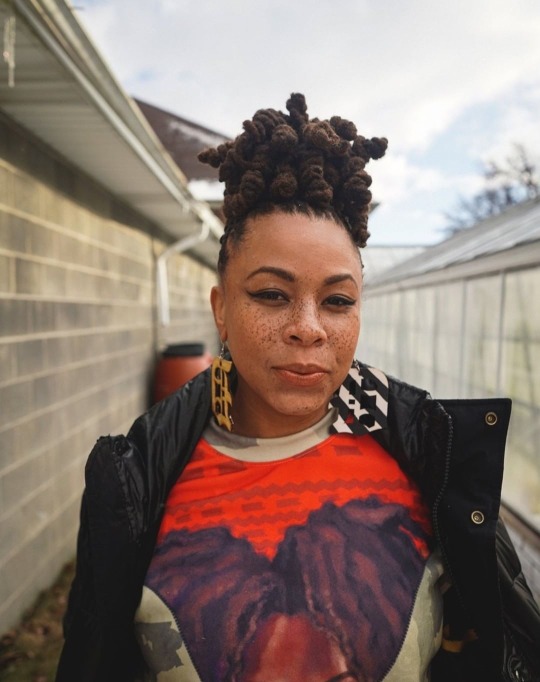
Reposted @janelombardgallery Jane Lombard Gallery is excited to present “Girl Raised in Detroit,” a solo exhibition by Detroit-based artist Sydney G. James. Following her recent exhibition at the Museum of Contemporary Art Detroit, “Girl Raised in Detroit” will feature new and existing large-scale sculptural paintings and installations. The featured works continue James’ exploration into themes of community, connectivity, and identity.
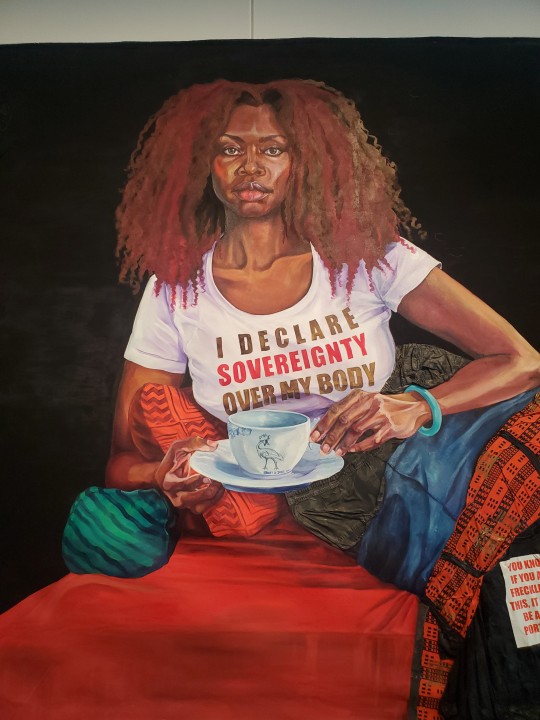
👚
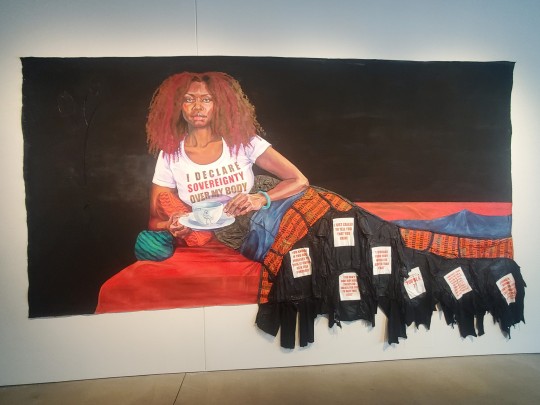
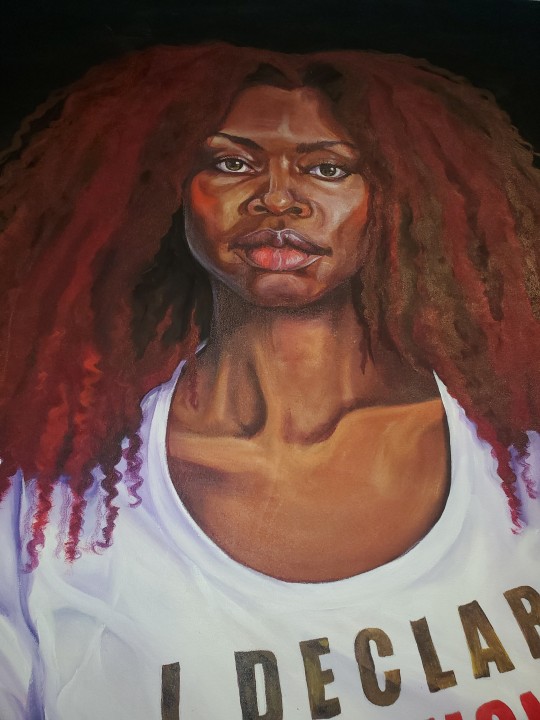

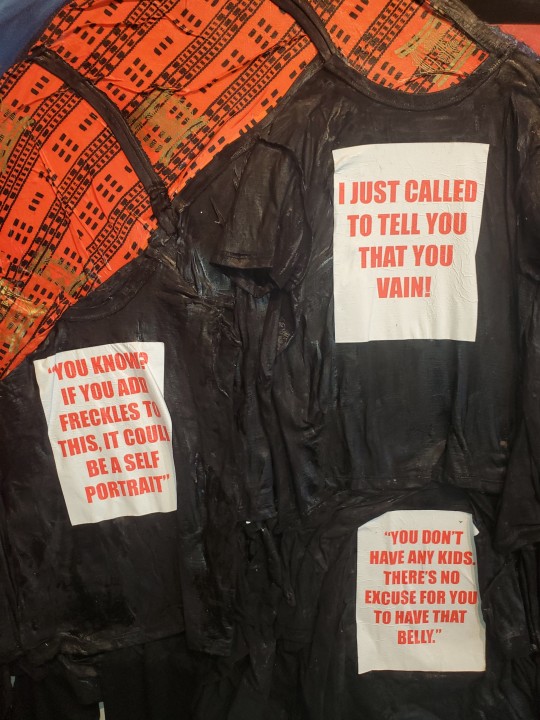

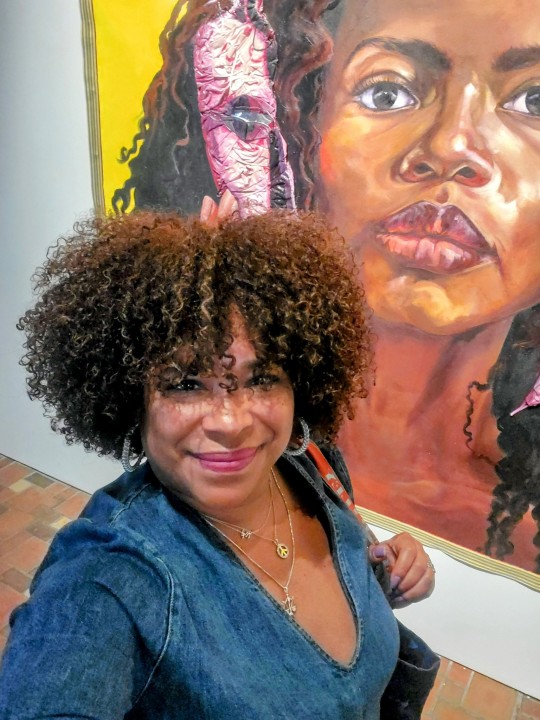
Known for taking on the walls of buildings as her substrate of choice, James pares down her portraits for Girl Raised in Detroit by a magnitude that delicately balances intimacy with monumentality. On canvas, James delineates members of her immediate circle on a larger-than-life scale using striking, vivid colors that evoke joy, pain, strength, and resilience. Orchestrating an artist-muse relationship that speaks to her subjects’ lived experiences and personal histories, James fosters an environment wherein both parties can engage in reciprocal emotional support. In her series Bereavement?, James depicts her subjects respectively shedding masks made from repurposed clothing items that carry personal traumas, acknowledging the freighted history of sequestering racial struggles behind a façade.
The artist seeks to establish spaces of freedom and security that mirror the creative sanctuaries of the city that raised her...
“Girl Raised in Detroit” opens with a reception on January 12 from 6 - 8 PM. Come meet the artist!
🔗read more:
____________________
Image 1: Sydney G. James, “Serving Tee Liberation,” 2023. Multimedia on canvas, 96 x 174 inches.
Image 2: Portrait of the artist. Photo by Lamar Landers. @sydneygjames
Images 3-7: Mine at MOCAD May 2023
#SydneyJames #Artist
#DetroitArtist #BlackArtists #BlackWomanArtist
#BlackGirlArtGeeks
#SydneyJames#Artist#Detroit Artist#BlackWomenArtists#New Exhibition#ArtAndTheCity#ArtIsAWeapon#GirlRaisedInDetroit#BlackGirlArtGeeks#JaneLombardGallery#SoundCloud
0 notes
Text
The books I have to read in the next 2 years are,
The Love Hypothesis: Ali Hazelwood
Shadow And Bone: Leigh Bardugo
Radio Silence: Alice Oseman
Harry Potter and the Half Blood Prince: J.K. Rowling
Harry Potter and the Deathly Hallows: J.K. Rowling
Red Queen: Victoria Aveyard
The Inheritance Games: Jennifer Lynn Barnes
World War Z: Max Brooks
Independent Study: Joelle Charbonneau
Killer Kung Pao: Vivien Chien
Ready Player Two: Ernest Cline
Mockingjay: Suzanne Collins
The Taking: Kimberly Derting
The Dating Plan: Sara Desai
All the Light We Cannot See: Anthony Doerr
The Rules For Disappearing: Ashley Elston
The Rules For Breaking: Ashley Elston
Charming and the Cherry Blossom: L.J. Evans
If I Stay: Gayle Forman
Peach Blossom Spring: Melissa Fu
Girl In Pieces: Kathleen Glasgow
The Fault in Our Stars: John Green
Paper Towns: John Green
The Summer I Turned Pretty: Jenny Han
Prince Charming: Rachel Hawkins
Her Royal Highness: Rachel Hawkins
Verity: Colleen Hoover
Ugly Love: Colleen Hoover
A Good Girl's Guide to Murder: Holly Jackson
Grey: E.L. James
Jay's Gay Agenda: Jason June
Love & Other Disasters: Anita Kelly
Under the Dome: Stephen King
Illuminae: Amie Kaufman & Jay Kristoff
Crazy Rich Asians: Kevin Kwan
Invaded: Melissa Landers
Starlight: Melissa Landers
Autoboyography: Christina Lauren
The Girl With Seven Names: Hyeonseo Lee
One Last Stop: Casey McQuiston
Cinder: Marissa Meyer
Midnight Sun: Stephenie Meyer
New Moon: Syephenie Meyer
Where the Crawdads Sing: Delia Owens
The Horsewoman: James Patterson
The Verifiers: Jane Pek
The Alice Network: Kate Quinn
Daisy Jones & the Six: Taylor Jenkins Reid
Divergent: Veronica Roth
Insurgent: Veronica Roth
Fangirl: Rainbow Rowell
Asylum: Madeleine Roux
Aristotle and Dante Discover the Secrets of the Universe: Benjamin Alire Sáenz
Salt to the Sea: Ruta Sepetys
Zom-B: Darren Shan
The Light Between Oceans: M.L. Stedman
The Loners: Lex Thomas
Enchantée: Gita Trelease
Code Name Verity: Elizabeth Wein
Black Dove White Raven: Elizabeth Wein
Rose Under Fire: Elizabeth Wein
Love & Gelato: Jenna Evans Welch
The 5th Wave: Rick Yancey
The Last Letter: Rebecca Yarros
Kingdom of Lies: Ben Alderson
Tell Me You Want Me: Willow Winters
City of Thieves: David Benioff
N0S4A2: Joe Hill
The Ex Hex: Erin Sterling
Don't Cry For Me: Daniel Black
Glitch: Briana Michaels
Twisted Game: Eva Ashwood
Ruin: Jolie Vines
Lord Eternal Night: Ben Alderson
The Fine Print: Lauren Asher
The Night Circus: Erin Morgenstern
The Deal: Elle Kennedy
New Year's Kiss: Lee Matthews
The Heir: Sophie Lark
West With Giraffes: Lynda Rutledge
Percy Jackson Lightning Thief: Rick Riordan
The Falling in Love Montage: Clara Smyth
Sugar Daddies: Jade West
Fifteen Hundred Miles From the Sun: Jonny Garza Villa
#book lover#bookaholic#booklover#booklr#booknerd#booktok#book aesthetic#book review#romance books#books and reading
0 notes
Link

Gracia Real de Santa Teresa de Mose, or Fort Mose (pronounced MOH-say), was established in 1738. It is now considered the first free black settlement in what would become the United States of America. Alternatively spelled Mosa, Moosa, Mossa, and Moze — translated to moss in all respects — Mose was the last stop on the original Underground Railroad, which began in the South and pointed not north but further south, toward a pine forest on a swamp facing the Atlantic Ocean. To the edge of St. Augustine.
No discussion about Fort Mose opens without Francisco Menendez (no relation to Pedro Menendez de Aviles). Menendez was a Mandinga boy captured in his West African home and enslaved in the British colony of South Carolina. He had twice escaped from slavery, disappearing into the coastal swamps of Carolina and Georgia, where he lived for years among the Yamasee Indians and led his first successful military campaign against his former masters in the Yamasee War. Menendez was fated to become the revered captain of the free black militia in St. Augustine, and a founding member of Fort Mose.
In 1725, a group of runaway slaves turned up in St. Augustine seeking refuge in the rumored Spanish sanctuary state. They had fled Charleston, South Carolina, after word spread of a royal decree from the Spanish king that promised liberty to all fugitives who came to Florida seeking Catholic conversion. They were led by Francisco Menendez (given that name in baptism once he arrived in Spanish territory, his birth name is unknown). Unlike their neighbors to the north, Spain had largely attenuated their slavery practices by the turn of the 18th century. Historian Jane Landers notes in her seminal book Black Society in Spanish Florida that runaway slaves from British plantations had been fleeing to Florida since the late 17th century. The first documented runaways from Carolina made it to St. Augustine in 1687. And then again in 1688, 1689, and 1690.
#st augustine#florida#florida history#spanish america#black history#francisco menendez#ponce de leon#fort mose#Manuel de Montiano#atlantic history#enslaved people#history of slavery#atlantic slavery#16th century#17th century#18th century#20th century#archaeology#Kathleen Deagan#Jane Landers#Jack Williams
5 notes
·
View notes
Text
ROUND ONE NAVIGATION
Rachel Phantomhive vs William T. Spears
Elizabeth Midford vs Alois Trancy
Undertaker vs Pops
Blavat Sky vs Drocell Keinz
Jane vs Grelle Sutcliff
Mey Rin vs Frederick Abberline
Ronald Knox vs Edgar Redmond
Alan Humphries vs Ash/Angela Landers
Lau vs Herman Greenhill
Tanaka vs Othello
Charles Grey vs Soma Asman Kadar
Doll vs Sebastian Michaelis
Snake's snakes vs Nina Hopkins
Sieglinde Sullivan vs Bard
Sascha vs Agni
Angelina Dalles vs Vincent Phantomhive
Wolfram Gelzer vs Lawrence Bluewer
Gregory Violet vs Hannah Annafellows
Ciel Phantomhive vs Ran Mao
Snake vs Ludger
Butler Grelle vs Finnian
Eric Slingby vs Thomas Wallis
Charles Phipps vs Joker
Sharpe Hanks vs "Ciel" Phantomhive
Good luck to everyone!
20 notes
·
View notes